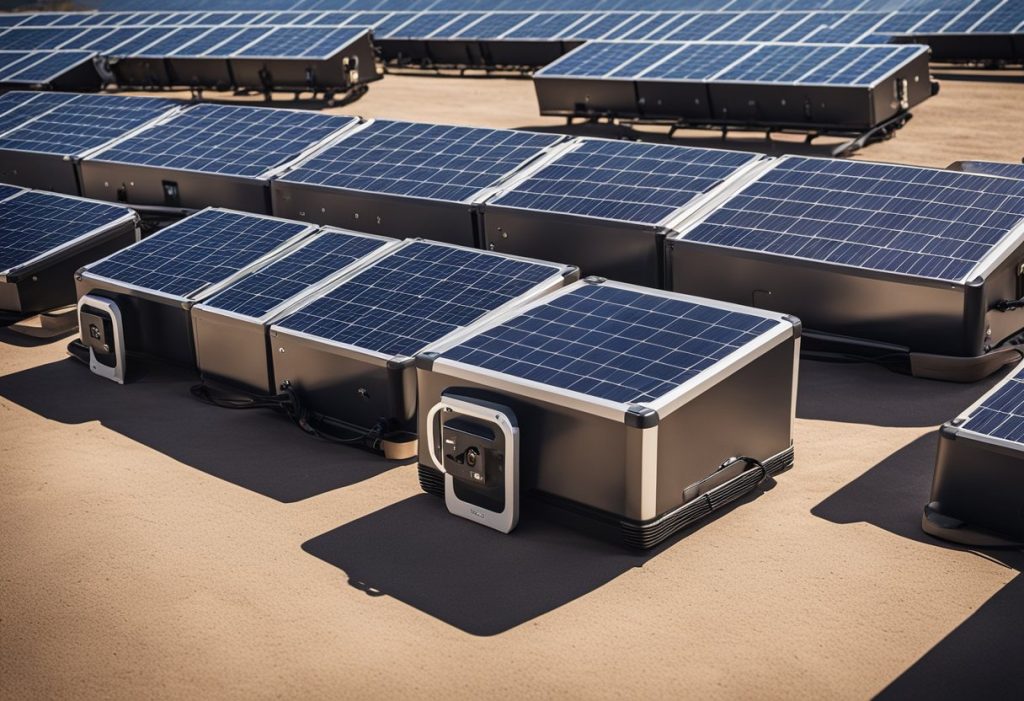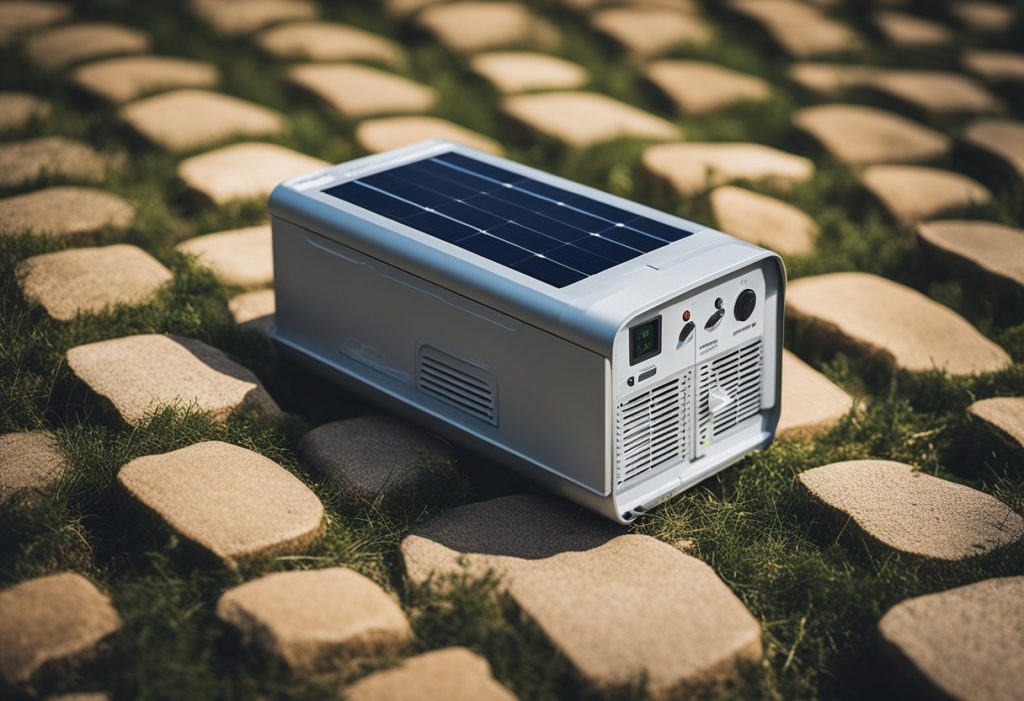Solar Powered Portable Power Stations with Lithium Batteries: The Ultimate Solution for Off-Grid Power Needs
Solar-powered portable power stations with lithium batteries are becoming increasingly popular as people seek alternative sources of energy. These devices are designed to provide electricity for various applications such as camping, outdoor events, and emergency situations. They are compact, lightweight, and easy to use, making them ideal for people who are always on the go.

Understanding Solar Powered Portable Power Stations
Solar-powered portable power stations are devices that convert solar energy into electrical energy. They consist of solar panels, a battery, and an inverter. The solar panels collect energy from the sun and store it in the battery. The inverter converts the stored energy into usable electricity. These devices are eco-friendly and do not emit harmful pollutants into the environment.
Lithium Batteries in Solar Powered Stations
Lithium batteries are commonly used in solar-powered portable power stations because they are lightweight, compact, and have a high energy density. They are also rechargeable and have a longer lifespan compared to other types of batteries. Lithium batteries are designed to withstand extreme temperatures and are safe to use.
Key Takeaways
- Solar-powered portable power stations are eco-friendly devices that convert solar energy into electrical energy.
- Lithium batteries are commonly used in solar-powered portable power stations because they are lightweight, compact, and have a high energy density.
- When selecting a solar-powered portable power station, consider factors such as the battery capacity, number of outlets, and charging options.
Understanding Solar Powered Portable Power Stations

As someone who has extensively used solar powered portable power stations, I can attest to their usefulness and convenience. These stations are essentially compact power banks that can be charged through solar panels, a 120-volt household plug, or a 12-volt car outlet. They are ideal for outdoor activities, emergencies, and situations where there is no access to a power source.
Components of a Solar Powered Portable Station
Solar powered portable power stations consist of several components that work together to provide power. These components include:
- Lithium-ion Battery: This is the heart of the power station and stores the energy generated by the solar panels or other charging methods. Lithium-ion batteries are lightweight and have a high energy density, making them ideal for portable applications.
- Charge Controller: This regulates the amount of charge going into the battery to prevent overcharging and damage to the battery.
- Inverter: This converts the DC power stored in the battery to AC power that can be used to power household appliances and devices.
- Solar Panels: These are used to charge the battery during the day when there is sunlight. The solar panels can be integrated into the power station or connected externally.
How Solar Powered Stations Work
Solar powered portable power stations work by harnessing the energy from the sun and storing it in a battery for later use. The solar panels convert the sunlight into DC power, which is then fed into the charge controller. The charge controller ensures that the battery is not overcharged and that the power is stored efficiently.
When you need to use the power station, the inverter converts the DC power stored in the battery into AC power that can be used to power your devices. Most solar powered portable power stations come with multiple outlets, including USB ports, AC outlets, and DC outlets, making them versatile and useful for a variety of applications.
Overall, solar powered portable power stations are an excellent investment for anyone who needs portable power. They are eco-friendly, reliable, and can provide power in situations where there is no access to a power source.
Lithium Batteries in Solar Powered Stations
As a solar power enthusiast, I have always been fascinated by the idea of portable power stations. These devices are incredibly useful for camping, hiking, and outdoor activities, as well as for emergency situations. One of the key components of these power stations is the battery. In recent years, lithium batteries have become the standard for portable power stations due to their many benefits.
Benefits of Lithium Batteries
Lithium batteries are lightweight and compact, making them ideal for portable power stations. They have a higher energy density than other types of batteries, which means they can store more energy in a smaller space. This allows for smaller and lighter power stations that are easier to carry around.
Another benefit of lithium batteries is their excellent thermal stability. They are less sensitive to high temperatures than other types of batteries, which means they are less likely to overheat and cause damage. This is important for portable power stations, which may be exposed to high temperatures during use.
Lithium batteries also have a longer lifespan than other types of batteries. They can be charged and discharged more times than other batteries, which means they can last for many years. This is important for portable power stations, which may be used infrequently and need to last for a long time.
Safety Measures for Lithium Batteries
While lithium batteries have many benefits, it is important to use them safely. Lithium batteries can be dangerous if they are not handled properly. Here are some safety measures to keep in mind when using lithium batteries in portable power stations:
- Do not expose the battery to high temperatures or direct sunlight
- Do not puncture or damage the battery
- Do not overcharge or overdischarge the battery
- Use a charger that is designed for lithium batteries
- Store the battery in a cool, dry place
By following these safety measures, you can ensure that your lithium battery-powered portable power station is safe and reliable.
Selecting a Solar Powered Portable Power Station
As someone who has extensively used and researched solar-powered portable power stations with lithium batteries, I have learned a few things about what to look for when selecting one. Here are some factors to consider and best practices to follow.
Factors to Consider
- Capacity: The capacity of a power station is measured in watt-hours (Wh). Consider what devices you will be powering and for how long. A higher capacity power station will be able to power more devices for longer periods of time.
- Battery Type: Lithium batteries are the preferred choice for solar-powered portable power stations due to their high energy density and long lifespan. However, not all lithium batteries are created equal. Look for power stations that use high-quality lithium batteries from reputable manufacturers.
- Solar Input: The solar input of a power station determines how quickly it can be charged using solar panels. Look for power stations with high solar input ratings if you plan on using solar panels to charge it.
- Inverter Output: The inverter output of a power station determines what devices it can power. Look for power stations with multiple AC and DC outputs and make sure they are compatible with the devices you plan on powering.
Best Practices
- Plan Ahead: Before purchasing a power station, consider what devices you will be powering and for how long. This will help you determine the capacity and inverter output you need.
- Invest in Quality: Don't skimp on quality when it comes to solar-powered portable power stations. Look for power stations with high-quality lithium batteries and reputable manufacturers.
- Use Efficient Devices: Use energy-efficient devices to maximize the battery life of your power station. LED lights, for example, use significantly less power than traditional incandescent bulbs.
- Keep it Charged: Keep your power station charged at all times, especially if you plan on using it during a power outage or off-grid camping trip. Use solar panels or a wall charger to keep it topped up.
Selecting a solar-powered portable power station with a lithium battery requires careful consideration of factors such as capacity, battery type, solar input, and inverter output. By following best practices such as planning ahead, investing in quality, using efficient devices, and keeping it charged, you can ensure that your power station will provide reliable power when you need it most.
Frequently Asked Questions
What is a portable power station?
A portable power station is a device that stores electrical energy in a battery and can provide power to electronic devices through various outlets. It can be charged through a wall outlet, a car charger, or a solar panel.
How does a solar powered generator work?
A solar powered generator uses solar panels to convert sunlight into electrical energy, which is stored in a battery. The stored energy can then be used to power electronic devices through various outlets.
What are the benefits of using lithium batteries in portable power stations?
Lithium batteries have a higher energy density, longer lifespan, and are lighter than other types of batteries used in portable power stations. They are also more efficient in charging and discharging, making them a popular choice for portable power stations.
What is the difference between a solar generator and a traditional generator?
A solar generator uses solar panels to convert sunlight into electrical energy, while a traditional generator uses fossil fuels such as gasoline or diesel to produce electricity. Solar generators are quieter, more environmentally friendly, and require less maintenance than traditional generators.
What are the features of the Jackery 500 portable power station?
The Jackery 500 portable power station has a 518Wh lithium-ion battery, multiple charging ports including USB and AC outlets, and can be charged through a wall outlet, car charger, or solar panel. It is also lightweight and portable, making it ideal for camping or outdoor activities. Other brands of portable power stations have similar features.
What size solar panel is needed to charge a portable power station?
The size of the solar panel needed to charge a portable power station depends on the capacity of the power station and the amount of sunlight available. As a general rule, a 100W solar panel can charge a 100Wh battery in about 6-8 hours of direct sunlight. However, it is recommended to check the manufacturer's specifications for the specific power station to determine the appropriate size of the solar panel.
Why are some companies switching to LiFePO4 batteries instead of lithium ion for portable power stations?
LifePO4 batteries have higher thermal stability and slower capacity degradation compared to lithium ion batteries. They also have a longer lifespan of over 2000 cycles. These safety and longevity advantages make LiFePO4 a better choice for portable power stations, despite their higher upfront costs.
